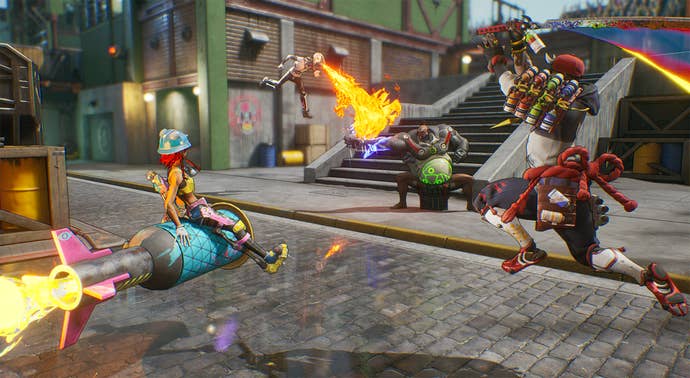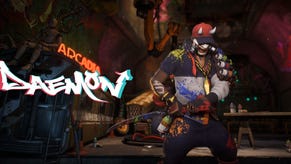Ninja Theory Opens Up: Its Barbecue With Rare, Overcoming Doubts About Bleeding Edge, and Avoiding Crunch
"Oh my god, we have a brother-sister relationship with another studio in the UK."
This article first appeared on USgamer, a partner publication of VG247. Some content, such as this article, has been migrated to VG247 for posterity after USgamer's closure - but it has not been edited or further vetted by the VG247 team.
When Ninja Theory first joined Microsoft Game Studios, the whole studio was invited to a barbecue with Rare. After the two hour journey from Cambridge to Twycross, Rare greeted the studio with t-shirts.
"The whole company got into a bus and drove up, and when we got there they gave us a t-shirt saying, 'Welcome to the family.' And we were like, 'Oh my god, we have a brother-sister relationship with another studio in the UK,'" Bleeding Edge principal animator Warwick Mellow remembers.
He pauses for a moment, then adds, "We're still getting used to it. Ninja Theory has been a staunchly independent company for such a long time."
Two years after its original acquisition, the U.K.-based studio is slowly but surely settling into the Xbox Game Studios family of game developers, which also includes Double Fine, Playground Games, and Obsidian. In some ways, not much has changed. Ninja Theory remains as independent as ever. In others, Ninja Theory is considerably better off.
Lead Artist Aaron McElligott, who has been around since the days of Heavenly Sword on the PlayStation 3, says Microsoft has been relatively hands-off in the period since the acquisition. "It was a worry that they'd be quite involved, because I've seen it before. Having a bit more money helps too. For the longest time, it was a struggle."
With Ninja Theory firmly ensconced in the Xbox Game Studios ecosystem, it has been working to build relationships with other studios. Rare in particular is one studio that Ninja Theory has been actively collaborating with as it prepares to launch Bleeding Edge, its new MOBA-like multiplayer action game set for release on March 24. Bleeding Edge creative director Rahni Tucker says Rare has provided guidance based on its own experiences with Sea of Thieves, which is now two years old.
Ninja Theory can certainly use all the help it can get. "The hardest stuff has been all the stuff that goes around the game: the matchmaking, the online services, player accounts, backend. How do we run a beta? It's all the stuff we haven't done before that's been really challenging," Tucker says.
Bleeding Edge is something of a passion project for Tucker. The concept was pitched even before Hellblade, and remained in limbo for a time before eventually being greenlit. Tucker was pleased because she enjoys competitive games and was excited to create one of her own.
Bleeding Edge's initial announcement at E3 2019 was met with puzzlement. This was the game that Ninja Theory was leading with? A strange-looking, oversaturated online game on an unpopular console?
Internally, Senior Sound Designer Daniele Galante says there was doubt about the reaction. "We really didn't know what to expect. At the beginning a lot of people were disappointed because they thought we were only doing multiplayer. That's not the case, as you can see, but once we finally managed to show the game finally, the feedback was amazing."
It was aided by the announcement of Hellblade 2: Senua's Saga later that year, which Mellow says brought with it with a "sigh of relief." After that, he says, players were more willing to engage with Bleeding Edge on its own terms.
The final product feels like a cross between a hero shooter like Overwatch and a MOBA like League of Legends. The characters are distinct and more than a little crazy—a punk samurai; a guitar-wielding fighter who reminds me a little of Lord Raptor from Darkstalkers; a dolphin. Its loud colors bring to mind Sunset Overdrive, which itself was a reaction to the grey and brown palettes that dominated the Xbox 360 era.
Ninja Theory's relationship with Microsoft in general, and Rare in particular, has been valuable in helping Bleeding Edge come together, Tucker says. "It's been really helpful that Microsoft came in halfway through development because it's allowed us to get in touch with Rare. They've done betas, they've got customer service. They've given us a springboard for some of our ideas."
Microsoft's assistance has also been useful because the Bleeding Edge team is far smaller than most triple-A studios. For comparison, Ghost Recon Breakpoint has more than 1000 developers scattered across eight studios worldwide. Bleeding Edge has around 20.
Ninja Theory's tiny team can be attributed to its "Triple-A Indie" philosophy, which has continued under Microsoft. Hellblade was when Ninja Theory began experimenting with this structure, which consists of small, agile teams working on triple-A quality games. But while the structure wound up working well under Hellblade, administering a full-blown online game with only a couple dozen people is obviously a very different challenge. It leads to lots of logistical challenges, like playtesting your game.
"It's really hard," Galante says. "When you test the game, you need eight people, and we have twenty. So every time we need to test the game, half the team is not working, which makes things a bit complicated."
What's more, Galante says most of the team had never even worked on a multiplayer game before Bleeding Edge. Galante himself is coming off Last Day of June, a heartfelt adventure puzzle game released in 2017.
Mellow agrees. "I think a lot of us went in a little bit naive as to how much there is to this type of game. If you think about how you have this many characters, this many maps, and we've only had one or two people per discipline."
McElligott chimes in, "We're very exposed. If Warwick doesn't turn up to work, we don't have animation."
Still, Ninja Theory is making it work as best it can. One of the benefits of working with such a small team, Tucker says, is that it's easier to get a feel for which ideas are good and which ones don't work as well. She says the team will often have "big brainstorming sessions" where one team member will pitch something, and the rest of the team will start adding to it.
The Bleeding Edge team can also actively collaborate over what works and what doesn't work. "The team has been playtesting the game for the last four years; like, we didn't have a QA department for the longest time, so we're kind of the first line of defense anyway," Tucker says. "We'll put a new character in, a new map in, and we'll have half the team yelling at us by lunchtime. So we're quite used to filtering that feedback and making changes quickly."
Bleeding Edge's reception has been very positive. Perusing the subreddit, there's little of the negativity typically associated with a new online game. One of the top-rated posts is titled simply, "I hope this game grabs the attention it deserves!" The tenor of the conversation may change as time passes and updates start to roll in, but for now things are looking good.
I got to play Bleeding Edge for myself earlier this week. I was a little leery because our reporter Eric Van Allen, who is big into MOBAs, felt that it was too simple and that the arenas were too big. I'll also admit to being a little put off by the incredibly exaggerated art.
Given some time with it though, I found that it was actually pretty fun. I tried several different characters, eventually settling on Gizmo, a ranged assassin who relies on gravity bombs, turrets, and a minigun to support her team. It's a fast-paced arena battler that in a weird way reminds me of Splatoon—perhaps because of the crazy colors—but with more complicated objectives.

It's kind of the perfect Xbox Game Pass game, actually, which I'm sure is one reason that Microsoft is eager to support it. It's not necessarily the sort of multiplayer game that you'd actively seek out and buy, but if you dabble in it for a little bit, it's easy to get hooked in. Watching internal analytics, Tucker claims one player actually went 14 hours straight on Bleeding Edge. If that's not an endorsement of your game, then I don't know what is.
Ongoing support will be a challenge for Ninja Theory. Some players, especially ones in Eastern Europe, have already started complaining about slow servers. The update pace is another issue. Last year, there was much discussion about developers at Epic Games having to crunch hard to keep up with the rapid pace of Fortnite's updates. Will a tiny team like the one at Ninja Theory be able to keep pace?
"Ninja Theory has a very non-crunch philosophy. Our philosophy is work smart to work fast, rather than work long hours to do a lot. We do what we can," Tucker says.
She says Ninja Theory already has a long list of ideas for potential updates. The team intends to monitor the community and prioritize the updates that wind up making the most sense.
Whatever happens, Bleeding Edge has proven to be an interesting first project for Ninja Theory under the auspices of Microsoft. It shows that the studio best-known for DMC and Heavenly Sword has more range than one might expect, and that its "Triple-A Indie" philosophy is quite flexible. If it's successful, and there's no reason to believe it won't be given Game Pass' track record to this point, it may open the door for the other projects you might not expect.
With that, I'd say Bleeding Edge is looking like a favorable result for both Ninja Theory and Microsoft's newly-formed collection of studios. More tests await. Bleeding Edge launches on Xbox One and PC on March 24.








